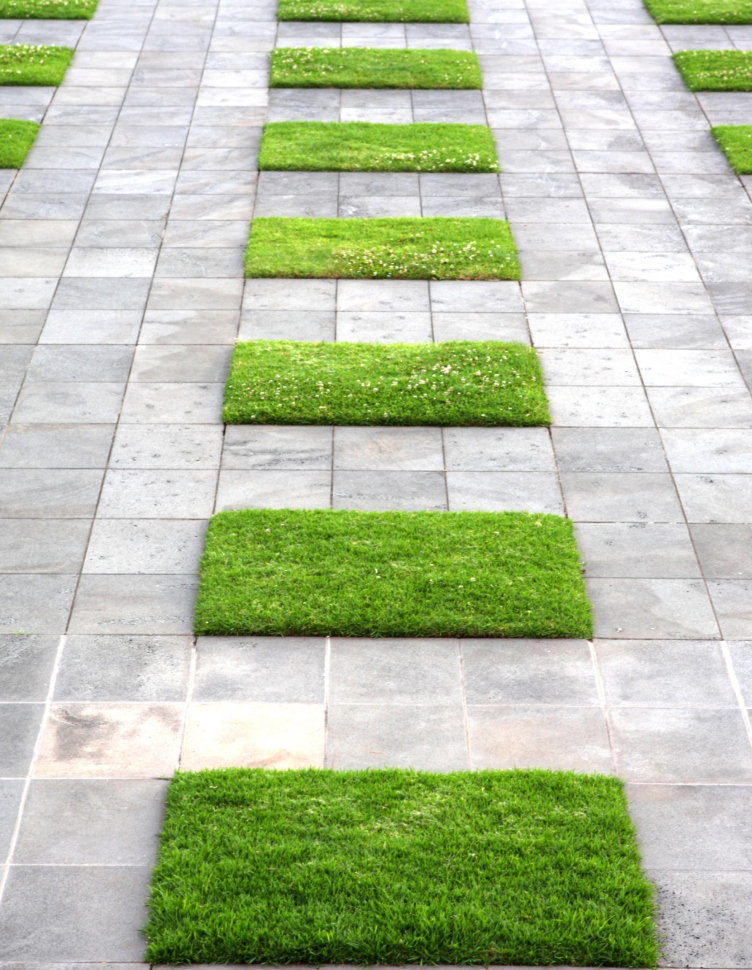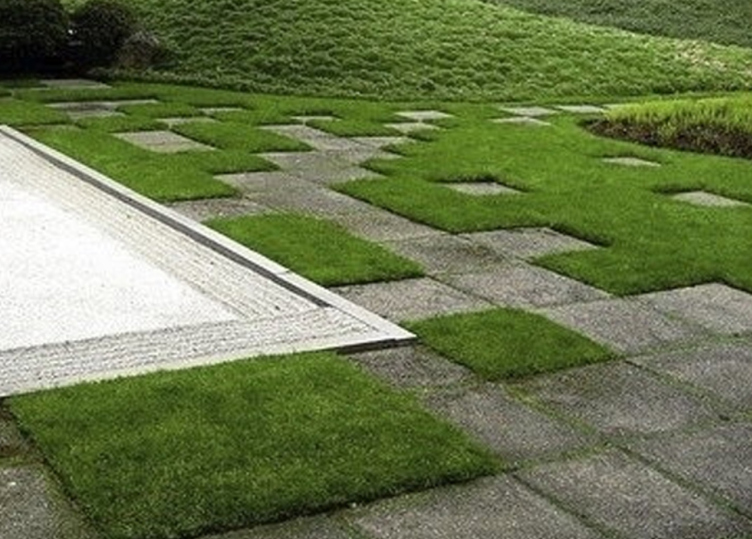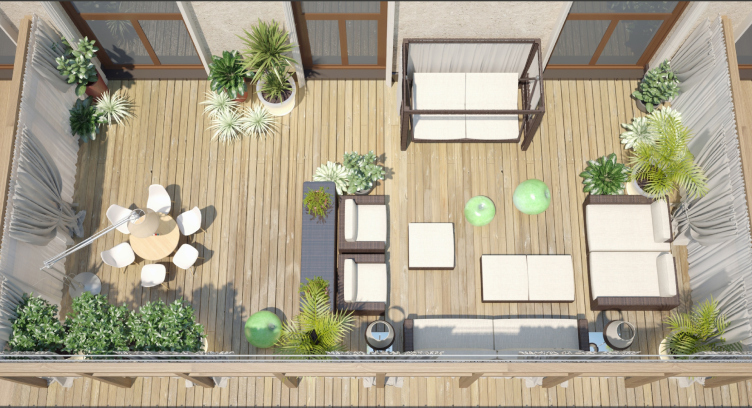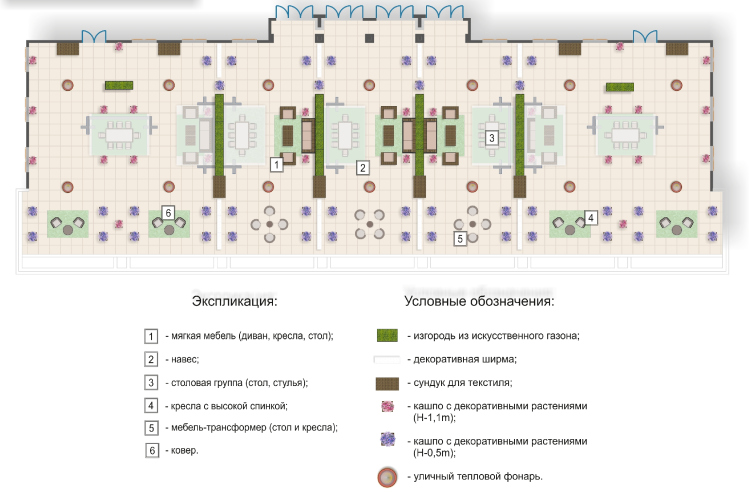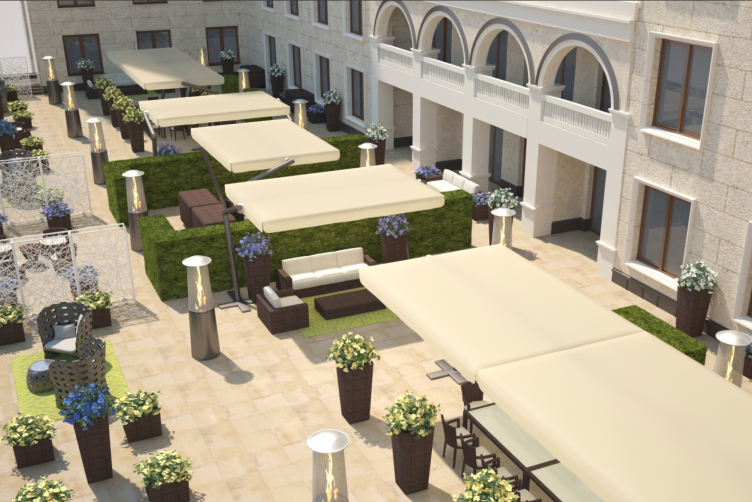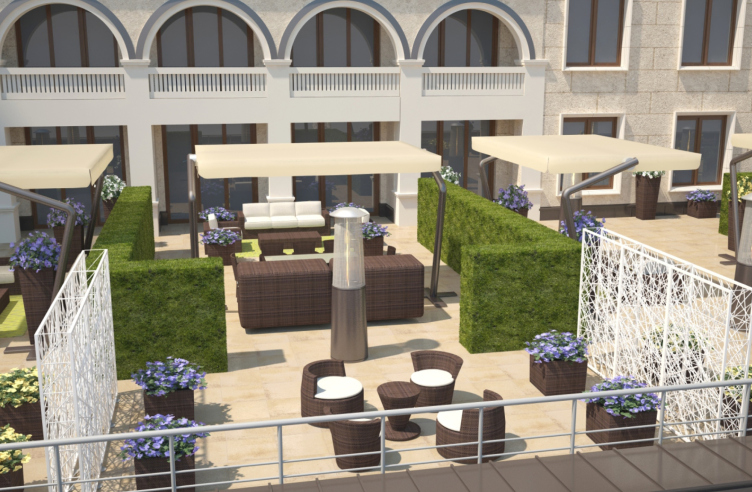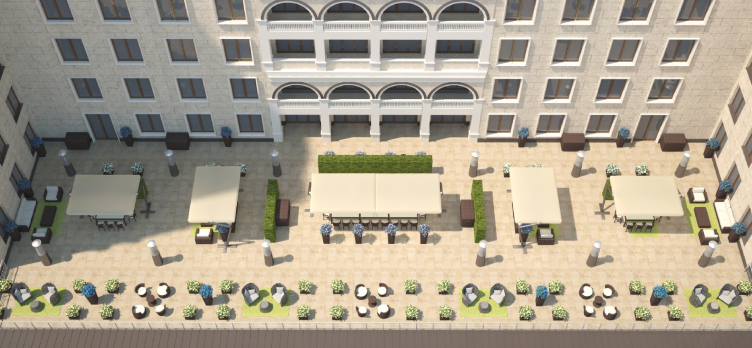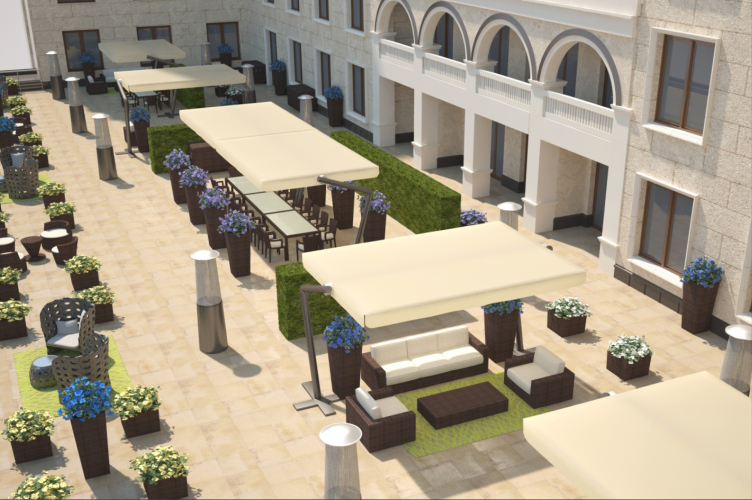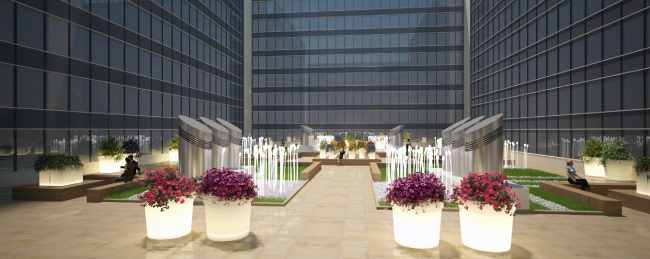
The courtyard of the office area. The first option.
The project of improving the territory of the renovated "Moscow" Hotel has been developed by "Arteza" landscape design studio since August 2013. It was at that particular time that the customer turned to the architects with a request to landscape the then-bare courtyards and terraces of the hotel by turning them into green territories pleasant to walk and take recreation in. The project includes three inner courtyards located in the living apartment area, as well as in the office and hotel part of the building, and the terrace in front of the president suite.
The courtyard is situated on the level of the sixth floor of the building and has a regular rectangular form on the plan. It is already paved and it has on in four symmetric flower beds that the landscape architects were to put some spin on. "Arteza" came up with several options of landscaping this territory, preserving and augmenting the existing structure.
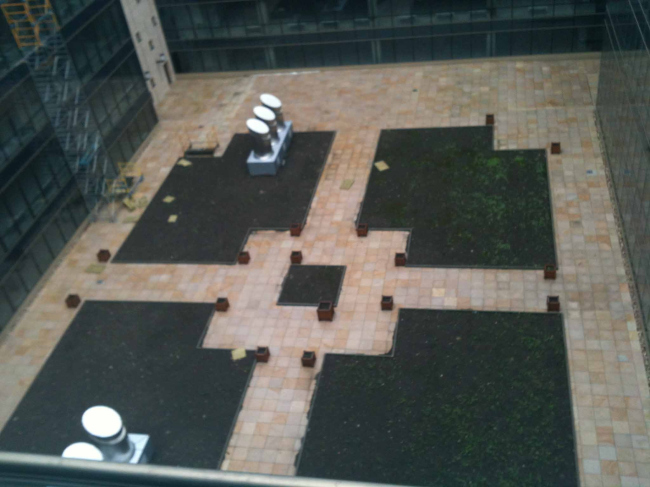
The courtyard of the office area. The present state.
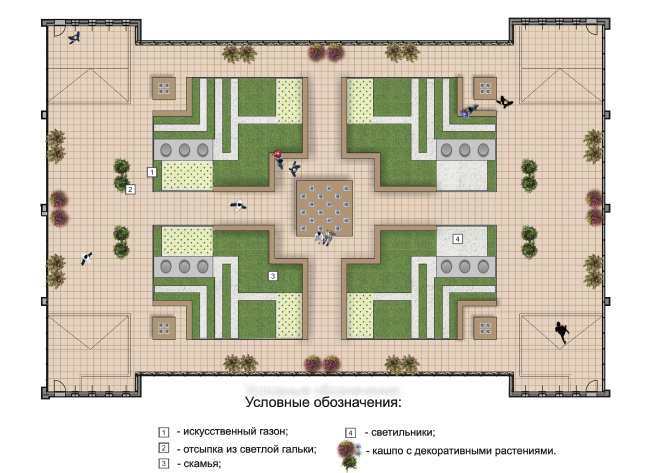
The courtyard of the office area. The first option. Master plan.
In the first option, the image of the territory is based on the combination of white decorative pebbles and an artificial green lawn. At this point, it is important to know that initially the customer planned to use exclusively natural grass (and for this purpose, part of the soil had already been brought in), but, upon a closer investigation of all the circumstances, the "Arteza" specialists convinced him to give up this idea. As Aleksey Pertsukhov, one of the authors of the project, explains, one of the main reasons against the natural greenery was the fact that it was only possible to create in the courtyard a very thin, literally 3-inch layer of soil which would not have been capable of holding the watering and water disposal systems. Instead, the authors suggested opting for the artificial lawn that visually is practically no different from the natural one: with the help of pebble filling work set against the green blanket of the lawn, the architects set the minimalist pattern of horizontal and vertical stripes of trails.
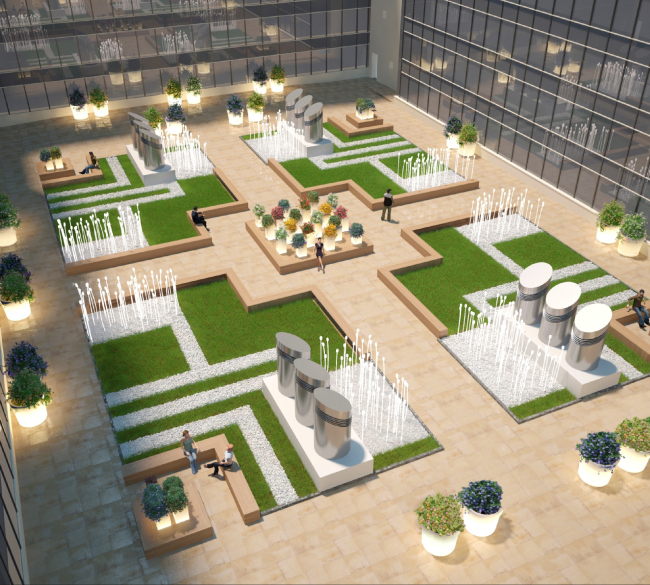
The courtyard of the office area. The first option.
In each of the "islets", the architects make two rectangular extractions, positioning them diagonally in respect to each other. Along the edge of each of these "hollows", there are benches, and before these benches, there are square stone tables behind which people can have their coffee, work, or simply visit with one another. The other two corners are marked by white pebbles that emanate the "streams" of the so-called "light fountain". These streams are in fact lightbulbs executed from semi-transparent plastic that are so light and agile that at the slightest gust of wind they produce a light and realistic-looking wave, thanks to which the artificial fountain looks very much like a real one. Even the intensity of light can be controlled here - which provides the opportunity for creating the effect of smooth coming on and off and backlighting.
Yet another eye-catching plastic accent in each of the islets are the two vent pipes, deliberately routed into the courtyard. It is planned that they will be raised on a snow-white podium and turned into metallic sculptural elements glittering in the sun. And, as for the central part of the yard, it will be left free of any permanent objects because this area will be reserved for conducting various events including those that presuppose the mounting of a stage. At other times, this area can be decorated by various compositions of glittering white cache-pots with bright blossoming flowers. Cache-pots of this same kind will be placed along the perimeter of the courtyard. They serve not only the decorative function but also the backlighting one; in fact, the cache-pots and the "fountains" will become the main source of light in the yard in the nighttime.
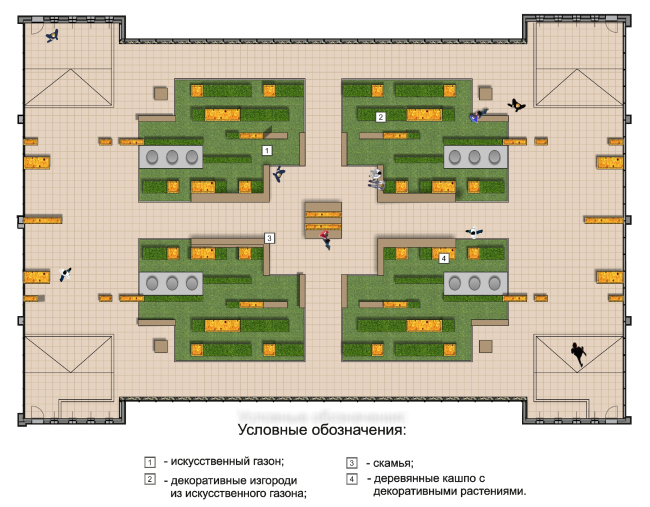
The courtyard of the office area. The second option. Master plan.
The second option of designing the office yard is different from the first in but one thing - the absence of the filling work. In this particular solution, the pebble trails give way to green fences executed by means of shaping various plants, so the visitors will be able to walk directly on the lawn that will look as if it were dissected into separate segments.
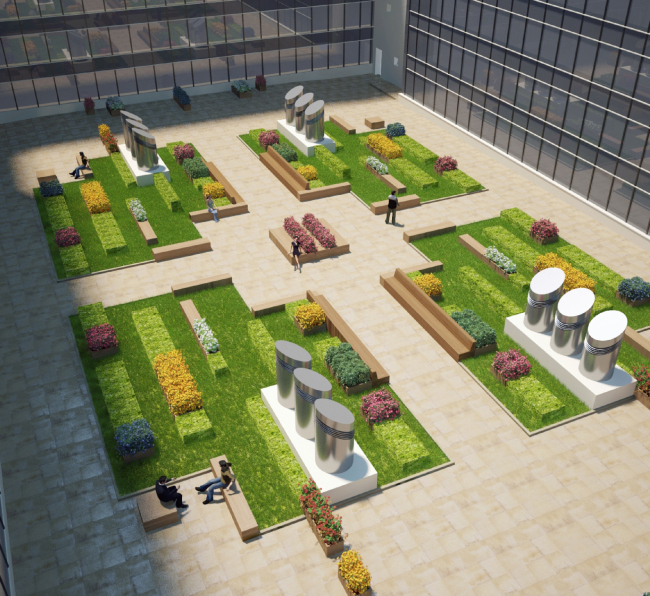
The courtyard of the office area. The second option.
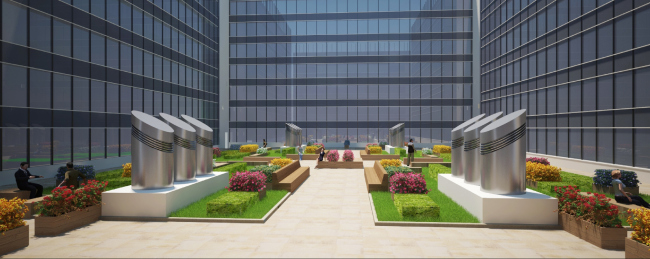
The courtyard of the office area. The second option.
The last option that was proposed by "Arteza" architects is arguably the most free-looking of all. In this version, the authors again turn to the lights executed in the "jet" shape but this time they make from them a dynamic diagonal stroke, very much like a riverbed of a whitewater river. The bottom of the river is marked by white filling work, while the banks are marked by dark colored, almost black, pebbles. Interesting is the fact that there are actually two streams - one of them crosses the yard by an exact diagonal, and the other touches the upper islets in a smooth arc.
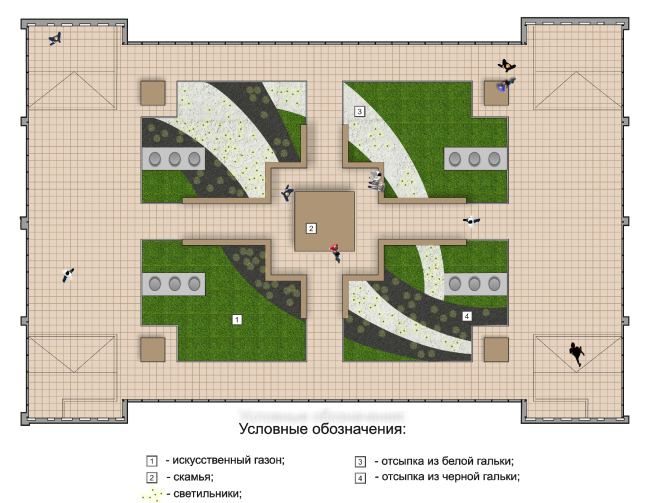
The courtyard of the office area. The third option.
The next area that needed improvement was the courtyard of the hotel itself. It also has a rectangular shape but its entire central part is occupied by the unusable roof of the swimming pool that rises a bit over the yard ground level. The guests of the hotel are not supposed to have access here, and thus the designers' main task was creating a beautiful view of the yard from the windows of the hotel rooms.
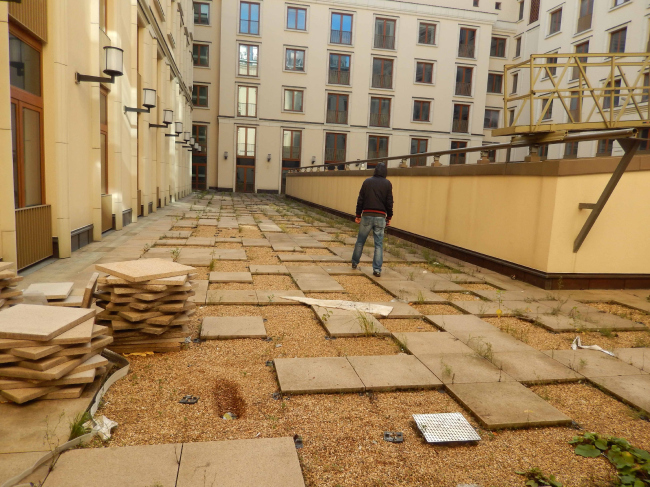
The courtyard of the hotel. The present state.
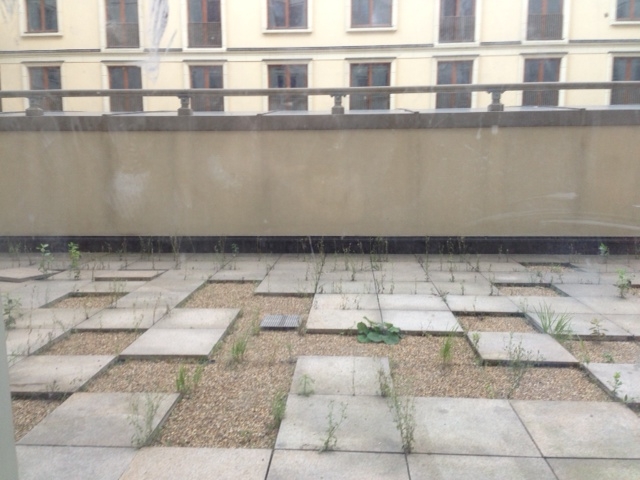
The courtyard of the hotel. The present state.
"When we first saw this place, it was an empty territory with half-dismantled paving stones - Aleksey Pertsukhov shares - It was at that particular moment that we had the idea of filling these "empty spaces" between the pavements stones and the green lawn so as to breathe new life into this place, and even some mischief along with it, if you like. Such a solution is really simple both to implement and to maintain later on". The stones, of course, had to be re-paved - thoroughly thinking out the location of each element of the paving order, the architects were able to create a harmonious and well balanced "pixel" pattern. Besides, there were designed the options for decorating walls surrounding the swimming pool roof. And the finishing touch of designing this territory became the already-familiar glittering cache-pots.
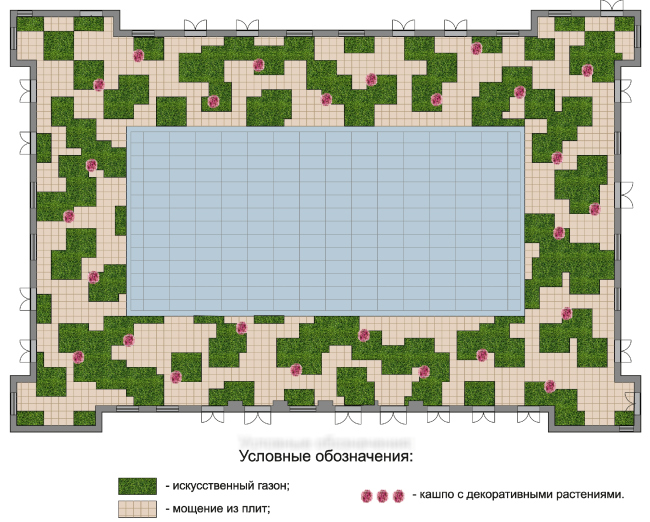
The courtyard of the hotel. Master plan.
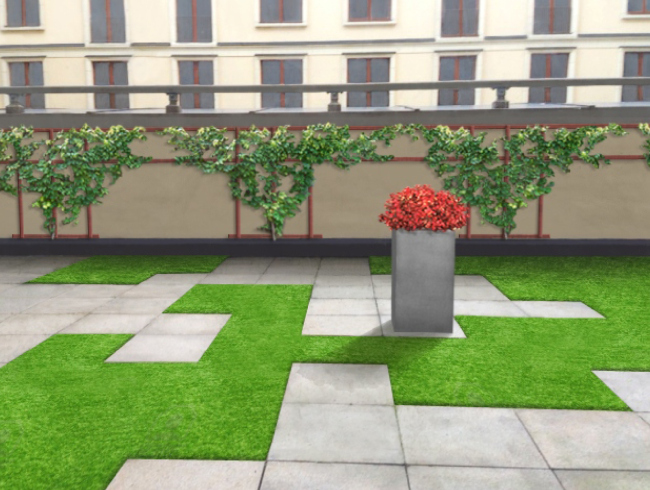
The courtyard of the hotel

The courtyard of the hotel. Combination of paving and lawn fragments.

The courtyard of the hotel. Combination of paving and lawn fragments.
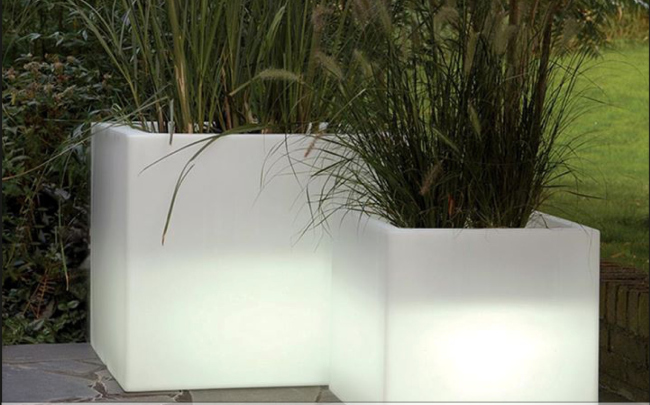
Courtyard of the hotel. Example of glowing cache-pots.
On the fifth floor, in the apartment section, there is yet another open atrium that is accessed from each of the apartments. "Arteza" proposed to treat its image as a union of cozy private little open-air yards separated by non-transparent walls from the rest of the courtyard. The architects were able to implement this idea by building a wooden framework with blind partitions. Made of wood-polymer composite, the floor boarding puts one in the mind of the terrace of a summer home, while, in order to eliminate the feel of a closed space, the authors of the project make imitation windows, clad in outdoor curtains. As a result, the atmosphere of the little yards is very close to that of an indoor space - even the furniture that architects selected for them, the kind that is capable of surviving the winter outdoors, looks intimate and warm, the type that would be able to fit even some luxury drawing room. The territory is planned out in such a way that it comfortably combines the dining area and the recreation area, the latter having in it, besides the wide armchairs, a bench swing. At the guests' request, living plants can also be brought in here, as well as designer interior objects - for example, giant green apples. A lot of thought was also given to the lighting system, as well to the scenario of operating these premises in the wintertime (all the structures are demountable).
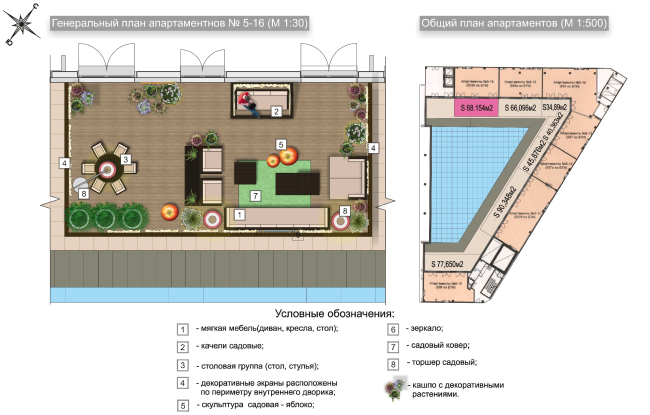
Courtyard of the apartments. master plan of the improvement and overview of the apartments.
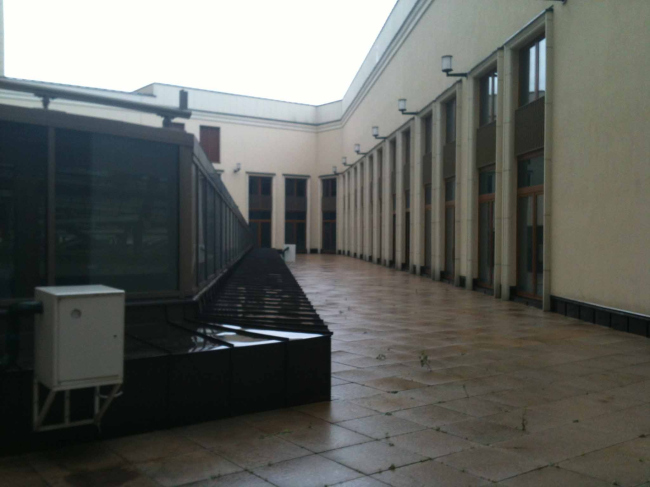
Courtyard of the apartments. The present state.

Courtyard of the apartments.

Courtyard of the apartments.
Commanding the view of the Kremlin and the Manezh Square, the grand terrace of the president suite is situated on the seventh floor of "Moscow" Hotel. It has connection to five large hotel rooms that, if necessary, can be united in a single whole. Accordingly, the terrace was also to get some "all-purpose" solution fit for using by one guest as well as several. The architects proposed to turn it into a transformable area that, very much like a Lego construction kit, can be assembled from the same elements. The zoning is done by green partitions and white openwork screens. Marked by wicker furniture and light-shade textile curtains, the dining and meeting zones are placed under broad awnings that provide protection from the wind and the rain. For heating and lighting the place, the architects propose to use open-fire gaslights. On the edge of the terrace, along the fence, there are also secluded places for the quiet contemplation of the views of historic Moscow.

Terrace of the president suite. Master plan. Layout for five guests.
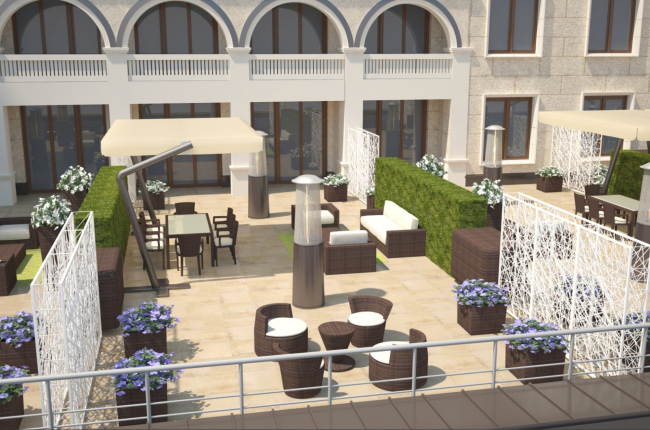
Terrace of the president suite. Layout for five guests.
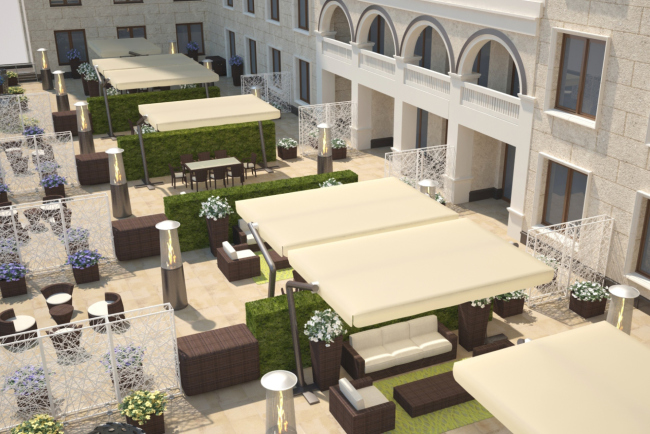
Terrace of the president suite. Layout for five guests.
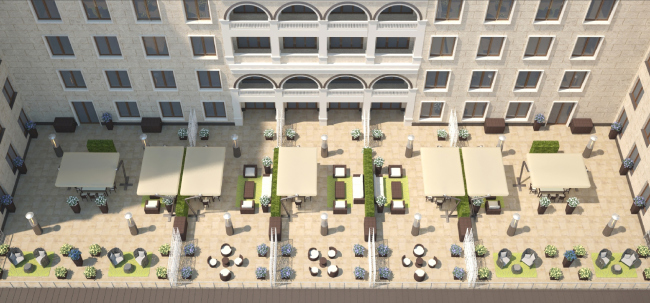
Terrace of the president suite. Layout for five guests.
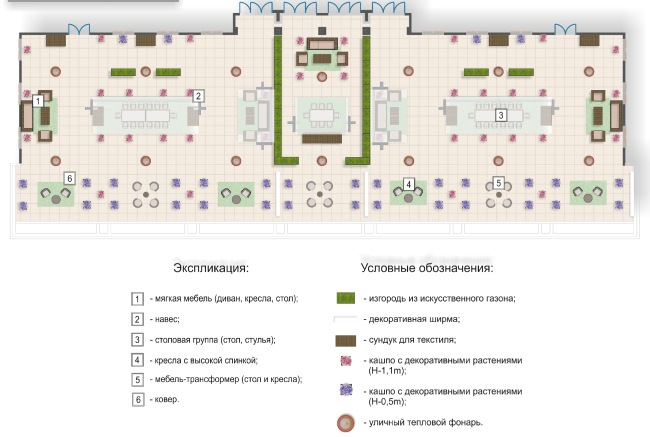
Terrace of the president suite. Master plan. Layout for two or three guests.

Terrace of the president suite. Layout for two or three guests.

Terrace of the president suite. Layout for two or three guests.
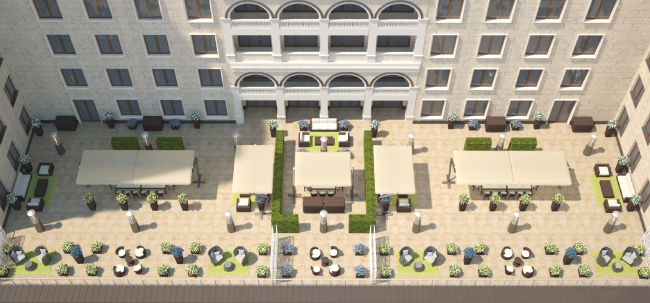
Terrace of the president suite. Top view. Layout for two or three guests.
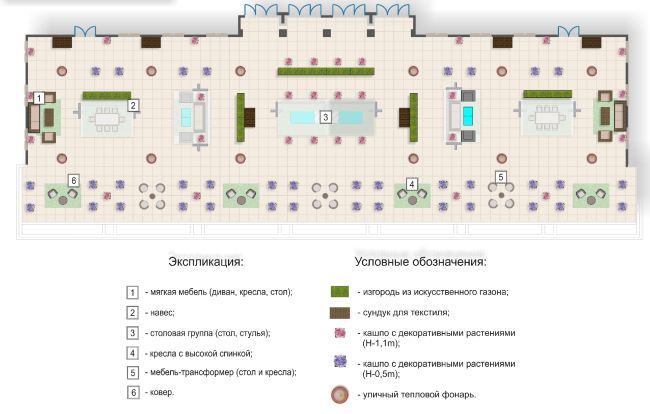
Terrace of the president suite. Master plan. Layout one guest.

Terrace of the president suite. Top view. Layout one guest.
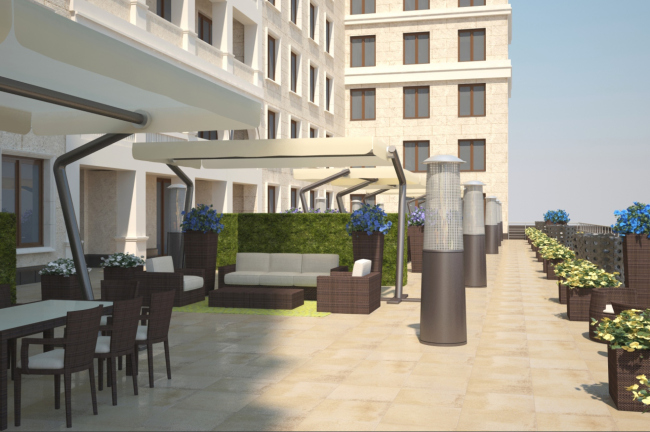
Terrace of the president suite. Top view. Layout one guest.

Terrace of the president suite. Top view. Layout one guest.
The meticulously thought-out concept of improvement of the hotel territory also includes scenarios for using the open-air spaces in the wintertime: it provides for heating the pavements, and contains options of Christmas decoration.
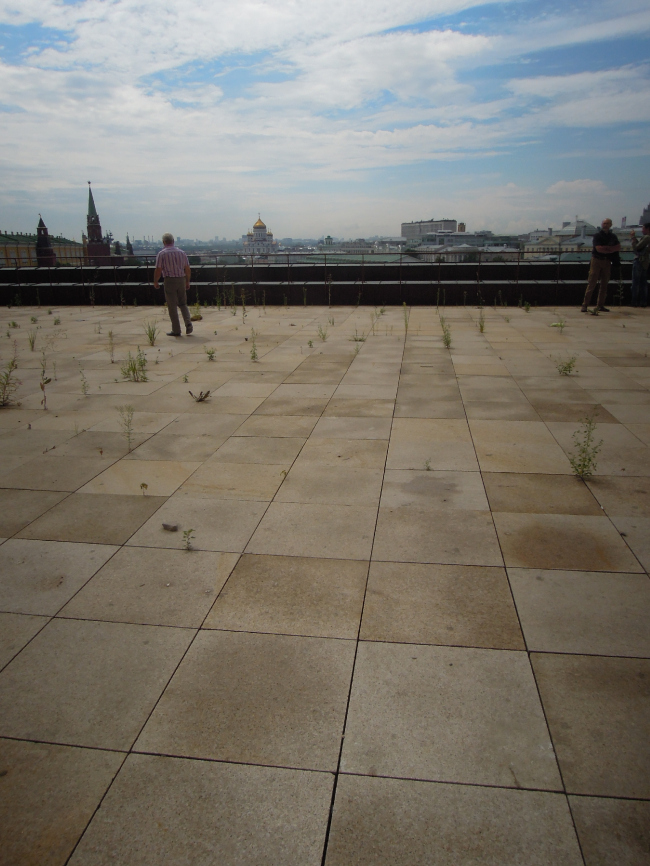
Terrace of the president suite. The present state.
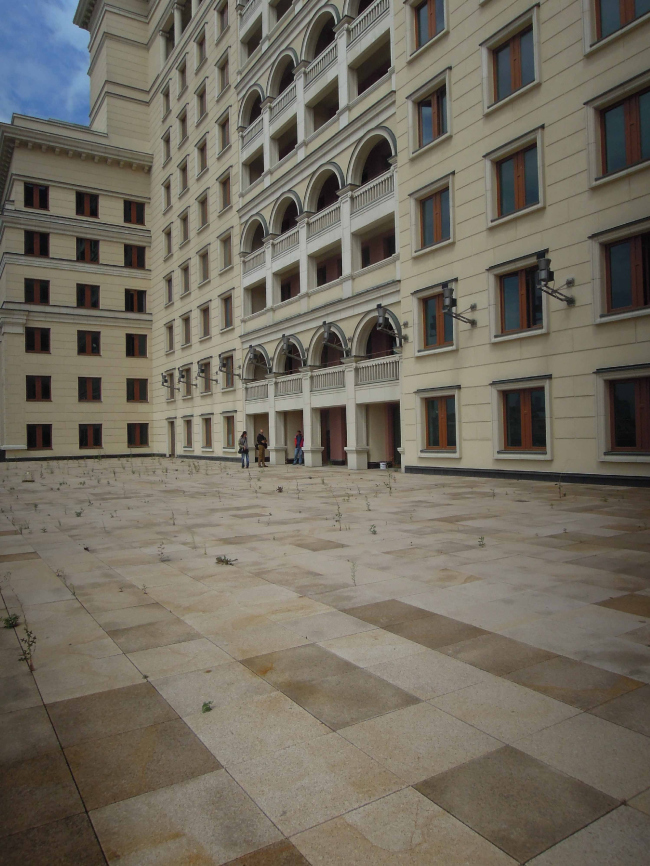
Terrace of the president suite. The present state.















